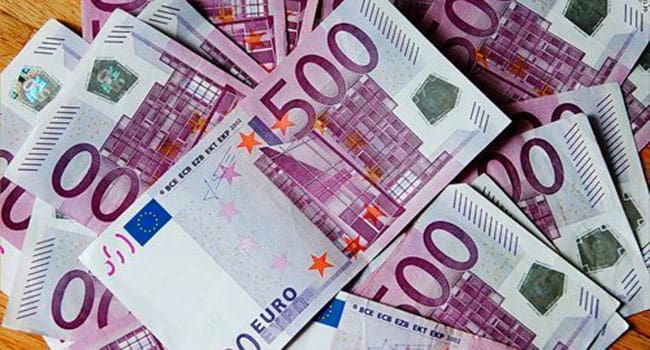 It’s time for Germany to abandon the euro – to save the European Union.
It’s time for Germany to abandon the euro – to save the European Union.
The euro is the official currency of the eurozone. It’s used by the institutions of the European Union (EU) and by 19 of its 28 members. It’s the currency of around 400 million people – the second most traded money and reserve currency. It was introduced as a unit of exchange in January 1999 and as a physical currency in January 2002.
Beginning in 2009, a sovereign debt crisis emerged among the 19 countries in the eurozone. Principally affected were Ireland, Portugal and Greece, which all required financial assistance from the European Financial Stability Facility (EFSF). Other countries, including Italy and Spain, saw a sharp rise in their government’s cost of borrowing. Portugal and Ireland have been stabilized, and Greece’s economic problems, while not resolved, have been contained so they no longer threaten the stability of the EU’s banking sector.
A second problem has been brewing, however. The Cyprus banking crisis was a preview of the steady rise of non-performing loans, now over one trillion euros, in the eurozone’s commercial banking sector. Italy is ground zero. Of Italy’s 500 banks, 114 are technically insolvent with bad loans exceeding their capital base. All but one of Italy’s five major banking groups (Mediobanca is the exception) have bad loans amounting to 90 per cent or more of their equity. Italy’s banking sector has at least 360 billion euros of bad loans – and the final number may be closer to 500 billion – against 225 billion in capital.
The Italian banking crisis is symptomatic of a larger problem, especially across the EU’s Mediterranean states – the growing non-competitiveness of their economies. Persistent inflation, often underreported, high unemployment, high consumer debt, and a lack of investment and credit have combined to create low-growth economies. While Italy is the poster child of the problem, the issues affect many EU states.
Purchasing power parity (PPP) is the idea that a unit of currency should buy the same amount of goods regardless of where you are. Discrepancies between countries are an indication of exchange rate imbalances that over the long term even out. For example, a euro will buy you 10 per cent more goods in Germany than in Italy. An average unit of labour in Germany buys you 59 per cent more goods than in Italy.
How does the loonie stack up to the U.S. dollar on a PPP basis? The assumption that the Canadian dollar should buy you the same amount of goods as the U.S. dollar implies an exchange rate of C$.85 to US$1, about 15 per cent higher than the current exchange rate.
Before the euro, countries could adjust for persistent inflation by devaluing their currencies. From the 1970s through the 1990s, the Italian lira dropped by 75 per cent against the U.S. dollar. That steady period of devaluations kept Italian industry competitive despite consistently high inflation.
In the eurozone, however, Italy is stuck with whatever exchange rate the euro trades at. Italy, like any country in the eurozone, can return to its old currency. Given Italy’s economic problems, the new lira would trade at a discount to the euro, creating a devaluation of the currency.
The rate would reflect the level of prices in Italy and expectations of future inflation, political stability and concerns about the liquidity of the banking sector. A PPP comparison between Italy and the rest of the eurozone would suggest the new lira would trade at a 10 to 20 per cent discount to the euro. But the rate would likely be highly volatile. PPP is a good indication of direction in exchange rates over the long term but a poor guide to determining equilibrium.
A de facto 20 per cent devaluation would spur Italian growth, drive exports up even faster (they’ve been growing faster than imports, but not enough to spur economic growth beyond an anemic one-plus per cent). The downside is the trillions of euro-dominated debt, government and private, that would now have to be paid back in more expensive euros. It’s unlikely the Italian economy, and the commercial banking sector, could take such a shock.
There is another alternative, however. Germany can leave the eurozone and return to the mark. Judging from PPP comparisons, the mark would probably trade at about a 25 per cent premium to the U.S. dollar and a 30 to 40 per cent premium to the euro. Post exit, the euro would probably fall to about US$.90, while the mark would trade around US$1.25. Exchange rates would be volatile as financial institutions, including central banks, rushed to dump euros and buy marks.
Italy and the other members of eurozone would benefit from a cheaper euro. German consumers and industry would get a windfall, paying off euro-denominated debt with more valuable marks. How big a windfall would depend on where the initial exchange rate was set. German exporters would have to deal with higher export prices, but they would have the benefit of lower import costs and the benefit of a de facto debt reduction. Switching to the mark would be deflationary for Germany, more reason to set the exchange rate low and give German consumers more buying power.
Managing an appreciating mark would be a challenge for the Bundesbank (the country’s central bank) and for German exporters. It’s a challenge Germany successfully faced before the introduction of the euro. Other countries, most notably the United Kingdom, have managed to thrive in the eurozone without adopting the euro.
Germany generates the largest balance-of-payments surplus of any country in the world. In 2016, it reached roughly US$300 billion – bigger even than China’s. Those surpluses are unsustainable over the long term. An appreciating euro would lower that surplus, but at the price of depressing economic growth elsewhere in the eurozone.
Germany must choose between continuing to participate in an increasingly dysfunctional eurozone, and all the financial obligations that come with that, or trade from outside with a more stable and competitive eurozone. That doesn’t mean that Germany would leave the EU, just the euro.
German voters, who are among the most pro-EU in Europe but increasingly unwilling to financially support other eurozone members, would likely support the return of the mark. Only by exiting the eurozone does Germany have any hope of saving the euro.
Joseph Micallef is an historian, best-selling author and, at times, sardonic commentator on world politics.
Joseph is a Troy Media Thought Leader. Why aren’t you?
The views, opinions and positions expressed by columnists and contributors are the author’s alone. They do not inherently or expressly reflect the views, opinions and/or positions of our publication.

